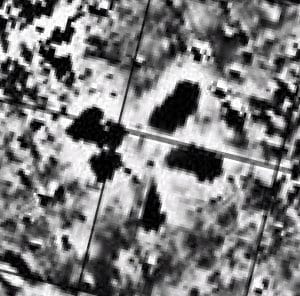We spent years researching a site in southern Hempstead County known as Dooley’s Ferry. It was, well, is, a neat project that we would like to go back out and do some more research on. The fieldwork completed to date, which was Dr. Drexler’s doctoral dissertation (Drexler 2013), had a lot of interesting things to say, based on the recovered data. But there was one thing that baffled all involved…
In 2010, the Survey conducted a series of geophysical investigations at Dooley’s Ferry, employing gradiometry, ground-penetrating radar, and electrical resistivity sampling techniques. The gradiometry, in particular, proved very useful in identifying densities of iron artifacts that pointed us to a number of former residences and even a church. But, in the south end of the data, there was this… thing.
What could it be? Equipment malfunction was unlikely, as the anomaly was consisted across grid lines, meaning the machine would have had to have failed numerous times in a patterned way spread across a long period of time, as we did not collect all four grids containing the anomaly in series. We metal-detected the area in the fall of 2012, and found basically nothing there that would account for it. There was one bullet. That was all. One bullet.
Absent a clear explanation, Dr. Drexler, tongue firmly lodged in cheek, decided it was an alien burial (Indiana Jones and the Kingdom of the Crystal Skull, with the highly-magnetic alien coffin, had come out a few years before) and let it rest, as we have other research priorities.
So things remained for years, until a chance discussion after last night’s Kadohadacho Chapter meeting and lecture, given by Dr. Amanda Regnier, of the Oklahoma Archeological Survey. She mentioned the possibility of it being a lightning-strike anomaly, as the OAS had encountered several in western Oklahoma (apparently Oklahoma is prone to strong storms… who knew?). She and Dr. Scott Hammerstedt provided some more information this morning (Maki 2005; Jones and Maki 2005), and it looks like we have a strong candidate for an explanation. The literature refers to such anomalies as lightning-induced remnant magnetism (LIRM).
Thanks to Drs. Regnier and Hammerstedt for pointing us in that direction. If other archeologists see this and can corroborate, we would appreciate a comment. If you have other interpretations, please leave them in the comments section, too.
References
Drexler, Carl (2013). Dooley’s Ferry: The Archaeology of a Civilian Community in Wartime. Unpublished PhD Dissertation, The College of William & Mary, Williamsburg, Virginia.
Jones, Geoffrey and David L. Maki (2005). Lightning-Induced Magnetic Anomalies on Archaeological Sites. Archaeological Prospection 12:191-197.
Maki, David (2005). Lightning Strikes and Prehistoric Ovens: Determining the Source of Magnetic Anomalies Using Techniques of Environmental Magnetism. Geoarchaeology 20(5):449-459.

